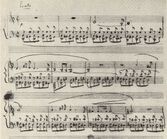



CGS - Copy by George Sand
| Date: | (1850⇒) |
| Title: | [Prélude] |
| Dedication: | None |
Copy made by George Sand (photocopy in: Korespondencja Chopina z George Sand i jej dziećmi, ed. K. Kobylańska, Warsaw 1981), the last of six Preludes copied by the novelist in an extensive album containing pieces by various composers, written down by various persons. As compared to the remaining sources to the Prelude, CGS stands out due to the way the majority of the L.H. part was written (b. 1-5, 8-16 and 18-19), i.e. the topmost notes of figuration (top notes of even quavers) were written down as a separate voice, undoubtedly in order to emphasise that they should be performed with the R.H. (1st finger). It is essential to determine whether it was Chopin that suggested such a notation and the resulting performing manner to the writer. According to us, it is highly likely:
- indicating the division of the text between the hands with the direction of stems was widely used already in the Baroque era; Chopin would also use it in teaching annotations, e.g. in the Prelude in B
 major no. 21, b. 47, or in the Nocturne in C
major no. 21, b. 47, or in the Nocturne in C minor, Op. 27 No. 1, b. 27-28;
minor, Op. 27 No. 1, b. 27-28; - long intimacy between Chopin and George Sand, including, i.a. the time the Preludes were being composed, particularly their common stay in Majorca, where ailing Chopin was working on the completion of A.
The fact that the copy was prepared on the basis of FE (except the manner in which the L.H. part was written down) is supported by the following arguments:
- full compliance in terms of layout (division into lines);
- the L.H. phrase mark in b. 1-4 having been placed under the bottom stave and its continuation in b. 5-8 – over (see the note on b. 5-10);
- no arpeggio in b. 22;
- more distinct similarities of this kind in the remaining preludes copied by George Sand, in particular in the Prelude in E major no. 9.
FE as the basis for CGS could be reconciled with a notation indicating that the quaver accompaniment should be performed with both hands if, e.g. there were a copy of FE with Chopin's annotations belonging to George Sand. Actually, it is quite likely, since the writer's daughter, Solange Clésinger, mentions in her memoirs a copy of Preludes given by the composer to her mother*.
The year 1850, which we give as the terminus post quem for the creation of the CGS, results from the information provided by J. J. Eigeldinger** that the ink used to write the copies of the Preludes was not used by the writer before 1850.
The range of dates marking the time frame for the creation of CGS was suggested on the basis of the following grounds:
- If – which is highly likely – the preludes were copied on the basis of FE, it could not have happened before the release of that edition in September 1839.
- J. J. Eigeldinger states** that the ink with which the copies of Preludes were being written was not used by the writer prior to 1850, which would result in a terminus post quem for their creation.
* "George Sand avait donné un titre à chacun des préludes admirables de Chopin. Ils ont été conservés sur un exemplaire donné par lui [George Sand gave a title to each of Chopin's marvellous preludes. They were written down in the copy he gave to her]." Quote after: J. J. Eigeldinger, Le Prélude en ut mineur op. 28 no 20 de Chopin, "Revue de Musicologie", 2014, no. 1, p. 92.
** Ibidem.
| Original in: | Private collection |
| Shelf-mark: | None |

